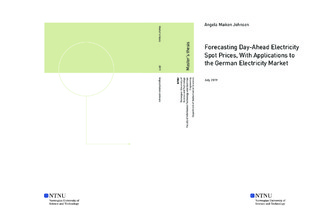| dc.contributor.advisor | Eidsvik, Jo | |
| dc.contributor.author | Johnsen, Angela Maiken | |
| dc.date.accessioned | 2019-10-26T14:00:26Z | |
| dc.date.available | 2019-10-26T14:00:26Z | |
| dc.date.issued | 2019 | |
| dc.identifier.uri | http://hdl.handle.net/11250/2624595 | |
| dc.description.abstract | Denne masteroppgaven har studert det tyske elektrisitetsmarkedet, i den hensikt å predikere neste dags elektrisitetsspotpriser. Tre modeller er presentert; den første modellen er en "persistence"-modell, som fungerer som en grunnmodell som kun inkluderer tidligere elektrisitetsspotpriser. Den andre modellen er en "rolling window regression"-modell (RWR), og den tredje er en tilstandsmodell. De to sistnevnte modellene inkluderer, i tillegg til tidligere priser for elektrisitetsspotkontrakten, også verdier til andre variabler som antas å påvirke neste dags spotpris. Disse inkluderer historiske olje-, kull- og gasspriser, spotprisvolatilitet og etterspørsel etter elektrisitet, for å nevne noen. RWR-modellen utnytter informasjon fra et vindu av tidligere dager, mens tilstandsmodellen kun tar i bruk informasjon fra dagen før.
Parameterestimering for RWR modellen foregår gjennom den tilsvarende minste kvadraters metode. For å estimere parametrene i tilstandsmodellen er et Kalman-filter blitt implementert. Estimatene fra begge modellene brukes så til å predikere spotprisene i tillegg til å utføre inferens.
Ved sammenligning av modellene ble det funnet at både RWR- og tilstandsmodellen ga bedre resultater en persistence-modelle, hvorav RWR-modellen hadde de mest presise prediksjonene. Dette tyder på at elektrisitetsspotprisene har lengre minne en en dag. I motsetning til persistence-modellen klarer både RWR- og tilstandsmodellen å fange opp noe av den stokastiske oppførselen til spotprisene. | |
| dc.description.abstract | In this thesis the German electricity market is studied, with the aim of predicting the day-ahead electricity spot prices. Three forecast models are presented; the first model being a persistence model, which serves as a baseline model, only incorporating previous values of the electricity spot prices. The second model is a rolling window regression (RWR) model, while the third model is a state-space model. The two latter models incorporate previous electricity spot prices in the model, as well as values of other fundamental variables that are assumed to influence the the day-ahead electricity spot price. These include historical oil, coal and gas prices, spot price volatility and electricity demand, to name a few. The RWR model uses information from a window of previous days, whereas the state-space model only considers the preceding day.
The parameter estimation of the RWR model is performed using the least squares equivalents of this model. As for the state space model, a Kalman filter is implemented to perform parameter estimation. The estimates from these models are then used to forecast the spot prices, in addition to perform inference on the estimates.
When comparing the models it is found that both the RWR and state-space model outperform the persistence model, with the RWR model having the most accurate predictions. Evidence indicates that this is due to the electricity prices having larger memory than one day. Unlike the persistence model, both the RWR model and the state-space model manage to capture some of the stochastic nature of the spot price. | |
| dc.language | eng | |
| dc.publisher | NTNU | |
| dc.title | Forecasting Day-Ahead Electricity Spot Prices, With Applications to the German Electricity Market | |
| dc.type | Master thesis | |
